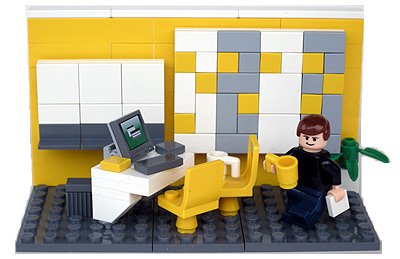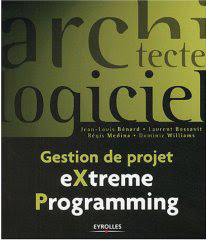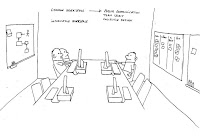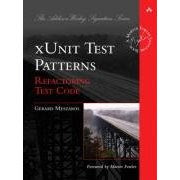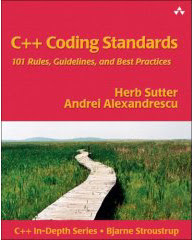 This book is full of great advice - even if you don't code in C++! I read it in parallel of a one-week training session in advanced C++. The training sessions contents and the books chapters matched quite precisely. It enabled me to put a name on a coding "pattern" I was unsing on my project: the Non Virtual Interface (NVI). Coupled with a design-by-contract practice (refer to Bertrand Meyer) implemented in code through assertions, this pattern can really improve your code.
This book is full of great advice - even if you don't code in C++! I read it in parallel of a one-week training session in advanced C++. The training sessions contents and the books chapters matched quite precisely. It enabled me to put a name on a coding "pattern" I was unsing on my project: the Non Virtual Interface (NVI). Coupled with a design-by-contract practice (refer to Bertrand Meyer) implemented in code through assertions, this pattern can really improve your code. lundi 30 juillet 2007
C++ CODING STANDARDS. 101 RULES, GUIDELINES, AND BEST PRACTICES, Herb Sutter, Andrei Alexandrescu
 This book is full of great advice - even if you don't code in C++! I read it in parallel of a one-week training session in advanced C++. The training sessions contents and the books chapters matched quite precisely. It enabled me to put a name on a coding "pattern" I was unsing on my project: the Non Virtual Interface (NVI). Coupled with a design-by-contract practice (refer to Bertrand Meyer) implemented in code through assertions, this pattern can really improve your code.
This book is full of great advice - even if you don't code in C++! I read it in parallel of a one-week training session in advanced C++. The training sessions contents and the books chapters matched quite precisely. It enabled me to put a name on a coding "pattern" I was unsing on my project: the Non Virtual Interface (NVI). Coupled with a design-by-contract practice (refer to Bertrand Meyer) implemented in code through assertions, this pattern can really improve your code. LEAN SOFTWARE DEVELOPMENT, by Mary and Tom Poppendieck
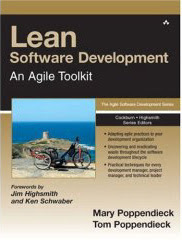 This book made me understand how many things in my company where far from being efficient!
This book made me understand how many things in my company where far from being efficient!PRACTICES OF A AGILE PROGRAMMER, Andy Hunt, The Pragmatic Programmers
 I had to read this book, as it has both "practices" and "pragmatic" in the title.
I had to read this book, as it has both "practices" and "pragmatic" in the title. It is a great catalog. It is designed in short chapters (~2/3 pages) which gives a real rythm to the reading.
What I put into practice:
+ I use CruiseControl to automate the one-action build of my current project;
+ I work from the list.
I RECOMMEND THIS BOOK.
AGILE SOFTWARE DEVELOPMENT, by Robert Martin
 It is great to have the oo-principles explained in one same book.
It is great to have the oo-principles explained in one same book. What I put into practice:
+ I adaped Uncle Bob's dependy metrics tool (depend.sh) for Ada95 and plugged it in our automated build;
+ I pay attention to the oo-principles when writting and reviewing code.
REFACTORING, by Martin FOWLER
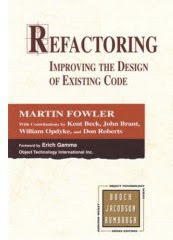 I really enjoyed the pragmatic approach to refactoring: run the tests, change the code in a little step, compile and run the tests, and so on.
I really enjoyed the pragmatic approach to refactoring: run the tests, change the code in a little step, compile and run the tests, and so on. The part on test-driven development is very clear and the article on the fact that the design is the code are just great.
This book is a must read!
What I put into practice:
+ I program in many little reversible steps;
+ I refactor ;o)
I RECOMMEND THIS BOOK.
EXTREME PROGRAMMING EXPLAINED, by Kent Beck
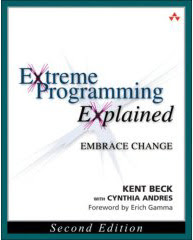 I read this book after starting to practice XP. It helped me understand how the practices worked so well together to achieve the principles.
I read this book after starting to practice XP. It helped me understand how the practices worked so well together to achieve the principles. GESTION DE PROJET EXTREME PROGRAMMING, by Regis Medina, Eyrolles.
CONCEPTION ORIENTEE OBJET, by Bertrand Meyer, Eyrolles

This book is pretty hard to read!
First, its a huge book. Too big for me to read in one go. So big reading it may seem discouraging. So I read chapters from time to time.
Second, it's complicated. Not because it isn't well written - but because the author explains the real issues of object-oriented programming.
The chapter on design-by-contract is fabulous. This is a practice which really made us improve our programming. This book is a reference.
What I put into practice:
+ My mentor made me apply design-by-contract with assertions.
+ I express design in source.
+ I autodocument the code.
I RECOMMEND THIS BOOK.
samedi 28 juillet 2007
MY JOB WENT TO INDIA, by Chad FOWLER, The Pragmatic Programmers
 This book is full of GREAT advice to improve your work on the short and long terms. Most of the advice isn't even restricted to IT jobs.
This book is full of GREAT advice to improve your work on the short and long terms. Most of the advice isn't even restricted to IT jobs. Reading it made me reconsider many aspects of my job. It helped me identify things I had to improve. Actually, the author even made me want to go work in Bengalore!
What I put into practice:
+ I suscribed to a programming magazine.
+ I made this blog.
I RECOMMEND THIS BOOK.
INFORMATION SHARING TOOL
CONTINUOUS INTEGRATION TOOL
TESTING TOOL
ISSUE TRACKING TOOL
We track bugs and issues with ClearQuest.
ClearQuest is meant to be coupled to ClearCase, which is a nice feature as version control and issue tracking are such interlinked practices.
Unfortunetly, we use the pair uncoupled!
This is one of these cases when big corporate top-down decisions just don't help ...
Therefore, we violate the "Don't Repeat Yourself" practice as we identify issues and the impacted code in the ClearQuest. Samewise, we identify the impacted code in ClearCase using activities named as the reference of the issue to solve.
BUILD VS BUY VS DOWNWLOAD
After a long legacy of "Build it", my company is now into "Buy it".
It's a real pity, as the best tools are actually free to download thanks to great open-source pojects!
TESTS

Programming in Ada95, we downloaded the AUnit open-source test framework.
Team-members actually began to enjoy testing, even though is was traditionally seen as boring activity.
In our common workspace, you can often hear: "Thank god these tests exist! They just detected a regression I added while changing the code ...".
PAIRING
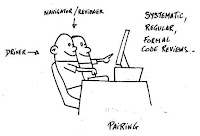 Lets face it: Some people just dislike pair-programming and you can't force them.
Lets face it: Some people just dislike pair-programming and you can't force them. We've never managed to practice systematic pairing. Too bad, because pair-programming is so efficient.
However, we've sort of transformed it into a "on-demand pairing" practice: "Hey, I've got this tough refactoring to do. Can someone come help me through this one?".
Its good to have a teammate ;o)
SYNCHRONIZE AND DELIVER AT LEAST ONCE A DAY
Instinctively, many developpers will keep their code checked-out overnight, or for several days.
That's another situation when it is good to share a common workspace. Indeed, you nearly always have a teammember to ask you: "You look satisfied with your tests results. Have you checked in and delivered your work?"
It's good to have a teammate ;o)
TEST-FIRST
This is a very tough discipline!
Even though experiencing it clearly reveals better designs, it is very difficult to make it a practice.
TESTING
When a bug is detected, there is nearly controllable force pushing team-members to hack a quick correction.
That's when you need a common workspace with a colleague asking THE question: "Have you started by adding a test revealing the bug?".
It's good to have a teammate ;o)
SUB-CONTRACTING, OUT-SOURCING, OFF-SHORING
Even though everybody was fully competent and willing, everyone has suffered from contracts which enforced early decisions and following plans over responding to change.
HAVE A MENTOR
This personal practice is described in My Job Went To India [ChadFowler].
Fortunetly I have a coach in my job, and I seek a lot of advice from a very talented peer.
I also consider the authors of my favorite software engineering books as mentors. I track the lessons of Kent Beck, Robert Martin, Bertrand Meyer, Martin Fowler, Mary Poppendieck, Andy Hunt ...
OPEN-UP! READ SOFTWARE ENGINEERING BOOKS AND BROWSE THE WEB
Lets avoid re-implementing the wheel!
Books and the web contain so much available and useful information.
At first, reading books on my job was a self-imposed discipline. Now, I has become a real pleasure.
THE LIST
However my list doesn't contain the features and issues assigned to me on the project Kanban board (Don't Repeat Yourself!).
DESIGN BY CONTRACT
 According to Bertrand MEYER's design by contract practice (implemented into Eiffel), we specify class responsibilities in terms of pre-conditions and post-conditions.
According to Bertrand MEYER's design by contract practice (implemented into Eiffel), we specify class responsibilities in terms of pre-conditions and post-conditions. These conditions are evaluated in assertions.
Class invariants are also checked by assertions.
Combined with a test-driven practice, this is a great way to implement the stop-the-line culture. Furthermore, it a great way to build mistake-proof code, as a class instance may not be used without respecting its operations pre-conditions.
SHARED DESIGN
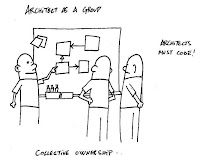 Design decisions are always taken as a team.
Design decisions are always taken as a team. At least one of the designer is then assigned the design to code and test.
If the design-decision is important, it is logged and justified into the design description document.
INFORMATIVE WORKSPACE
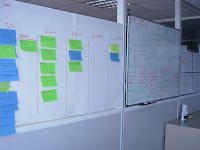 Whiteboards and large post-its show the design the team is currently working on.
Whiteboards and large post-its show the design the team is currently working on. Prioritized features and issues are described on post-its. They are moved along the sequential sections of a large Kanban board.
The sections are named TO-DO, ASSIGNED-TO, TO-REVIEW, TO-DELIVER and DONE.
The Kanban reprensents the team's workflow.
COMMON WORKSPACE
HIGH QUALITY
CONTINUOUS INTEGRATION
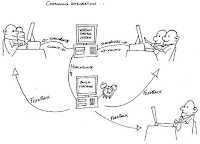
A continuous integration system automatically builds the application upon detection of modifications.
The build dashboard and the build artifacts may be freely consulted by managers and clients.
With this practice, integration is performed just-in-time.
ONE ACTION BUILD SCRIPTS
 The applications are build, tested and measured in one-action builds.
The applications are build, tested and measured in one-action builds. - produces the application,
- tests it,
- generates code to requirement traceability matrices,
- generates requirement to acceptance test matrices,
- measures code coverage by tests,
- measures feature (requirement) coverage by tests,
- generates detailed design documentation,
- generates UncleBob's depency metrics,
- generates quality metrics,
- generates to-do lists,
- profiles the code,
- etc ...
TEST-DRIVEN DEVELOPMENT

These are organized into unit-tests and acceptance tests.
The unit-tests and as many acceptance tests as possible are automated and self-checking.
We give proof of full code coverage and full feature coverage by the tests.
The tests are used to measure progress.
REVIEWS
REQUIREMENT BASED DEVELOPMENT

The features to develop are identified as high-level requirements.
The specific business algorithms to implement are identified as low-level requirements and traced to the high-level requirements which justify their existance.
The code is traced to the requirements.
The compliance of the application to its allocated requirements is verified by tests, formally traced to the requirements they check.
ISSUE TRACKING
VERSION CONTROL
DEVELOPMENT METHODOLOGIES

The company I work for has a long legacy of waterfall processes.
However, things are changing and locally we manage to apply Agile processes with interative and incremental cycles.
Still, we must give proof of compliance with our applicable certification norm.
COMPANY ENVIRONMENT
Its software applications must be certified by independant auditors before they are but into production.
The certification norm imposes requirements on planification, development process, quality assurance, change management, etc ...
To comply with these certification requirements, organizations often adapt a heavyweight attitude: heavyweight waterfall processes, heavyweight documentation and heavyweight expensive tools.
